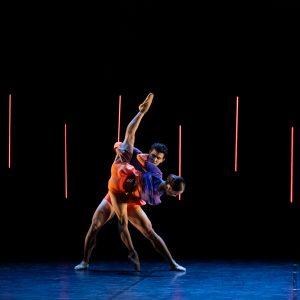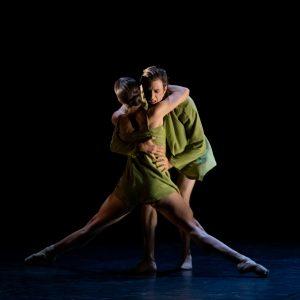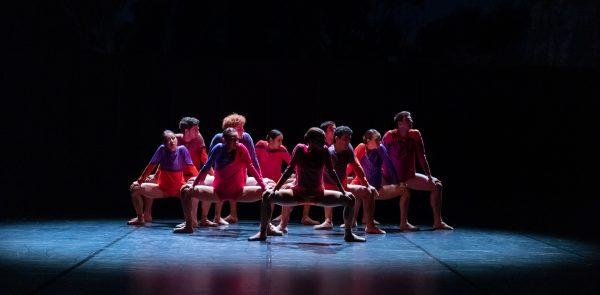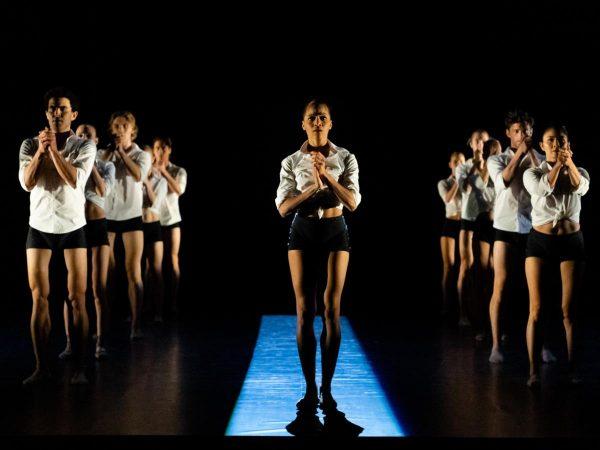The Coming Together of Life, Love, Lust, and Loss
11 Feb – 5 Mar at Quarry Amphitheatre
Reviewed by Courtney Allen
The Western Australian coast has an abundance of natural jewels in its crown in the summer months, however, two in particular spring to mind. Sunsets at City Beach, and the nearby outdoor City Beach Quarry Ampitheatre at dusk. The latter has been home to WA Ballet each February for many years and is the perfect venue for the commencement of the 70th anniversary of the oldest ballet company in Australia.

While the sun is still high, the arriving audience watches the company’s talented young dancers on stage during a warm-up class. As I look around, I notice many members of the audience pointing out their favourite dancers to one another. The setting is intimate: a gentle sea breeze, high limestone walls cocooning the audience and the final rays of sunshine casting a warm glow over the dancers’ long extensions.
Without further adieu, the evening’s performance commences with the first of four contemporary works: Reset from Brazilian-British choreographer Daniela Cardim to the music of composer Gabriel Prokofiev. The shapes and sequences that begin to fill the stage are a combination of the abstract and the familiar. At one stage, the dancers form a cluster on public transport. At another point, a dance floor battle erupts on a lit square in the centre of the stage. I am struck by the energy and passion of the dancers from the outset. It is therefore unsurprising to learn that the dancers have been invited into a collaborative process by choreographer Daniela Cardim, who encouraged the dancers to provide their own feedback on the choreography as it was workshopped and further developed.
Matthew Marshall’s lighting design is clean and contemporary, neither fussy nor stark. Neon lines fill the space and shift in colour along with the mood of Prokofiev’s music and Cardim’s choreography, which oscillates between flickers of 80s Olivia Newton-John on the one hand, and futuristic worker bees on the other. Towards the end of the work, the dancers shed layers of their costumes, like Olympic swimmers getting ready for their splash. Reset achieves its crescendo with the dancers performing a series of mesmerising duets spanning the breadth of the stage.

From international talent, the next work Truth shifts to a local face. WA Ballet’s Principal dancer Matthew Lehmann choreographed the second work, predominantly during the early stages of 2020 for WA Ballet’s Covid Lab season, before developing it further for Genesis 2021, and then further refining it over the following months and years. When I spoke to Lehmann after the performance, he spoke with great passion of the importance of the emotional core of dance performance, and with joy and willingness to share the stage with the upcoming young dancers and to play a part in facilitating their growth in the company. This generosity and emotional core was evident in the thoughtful choreography and humanistic qualities of the piece. The grey silk of the costumes was elegant and minimalistic, leaving breathing room for Lehmann’s sensual and deeply romantic choreography, brought to life by dancers Nikki Blain and Oliver Edwardson. It is an understatement to say that Truth is a visual expression of Ludovico Einaudi’s award-winning musical composition, Experience. The music and choreography combine so beautifully, that it becomes strangely possible to imagine that the dancers themselves are creating the music, through their movements. Truth lingered with me, hours after the show. My only regret was it’s brevity, and I hope there is an opportunity to see an extended version in a different setting from the emerging choreographic talent of Matthew Lehmann.
The evening’s third work, Concerto Impertinente! (translation: impertinent concert) was a collective choreographic effort of Nikki Blain, Chihiro Nomura, Kiki Saito, Claire Voss and Sandy Delasalle, under the creative and concept direction of Sandy Delasalle. The female dancers are an elegant vision in black and glittering costuming (also designed by Delasalle along with Bodile) reminiscent of ballroom dancers and the film Black Swan, displaying strength, fragility and power, and all working together in unity.
The emotional range of this piece was extraordinary. We are really taken on a journey through the limitless facets of what it means to be a woman in the world in 2022, as well as a woman in dance. The rewards of having multiple female choreographers contribute to the piece is evident, allowing for the diversity of their experiences to deepen the richness of the feminist work. The classical and neo-classical qualities of the choreography find their perfect home with Felix Mendelssohn’s music. The resilience of these women, dancers and choreographers, becomes all the more evident when I learn that the piece was developed throughout the 2020 Covid Lab series, however was unable to be premiered during that season as initially intended. That these women pursued this piece and stuck with it, further clarifying the choreography and distilling their ideas into a cohesive and well-connected piece throughout the continuing hardships of the pandemic is phenomenal.
The last performance of the night is Take Me With You, by award-winning Polish Choreographer Robert Bondara, who also is the Ballet Director of the Poznan Opera Ballet. The work has achieved significant acclaim through its digital recording and live performance internationally. While it was initially choreographed as a duet in 2016, the scale has shifted so significantly, with almost the entire WA Ballet company on stage at various points throughout the performance, dressed simply in black shorts and crisp white shirts. The electronic and art-rock sounds of Radiohead is instantly recognisable, however the dancers interpret the music afresh. Bondara’s reflections on his choreography ring true here:
Although it’s not traditional storytelling choreography, it wouldn’t be classified as abstract either, because behind each step and dancer are hidden, deeper thoughts and reflections waiting to be discovered. Our dreams, fears, aspirations, and social pressures to which we are exposed to, in efforts to find balance between our inner life and the outside world sets the tone and atmosphere of the piece that are expressed through the dancers’ bodies.
The athleticism of WA Ballet’s dancers cannot be overstated, and I am floored by their strength and versatility with every performance. These characteristics are given a chance to be exercised to their full capacity in Take Me With You, with some incredibly young dancers (including the newest Corps de Ballet artists) performing multiple lifts with fluidity and ease. Spinning shapes, deep plies and group lift pyramids erupt across the stage, forming and unfolding in time to Radiohead’s song Staircase, which sees the full cast on stage in synchronicity.
As the audience filters out into the warm dark night, the whispery vocals of Thom Yorke linger in our minds: And true love waits, In haunted attics, And true love lives, On lollipops and crisps, Just don’t leave, Don’t leave. Four performances and several hours later, it strikes me that the audiences of WA Ballet never want to leave. We are always left wanting more in the best possible way.
Once again, Artistic Director Aurélien Scannella has brought four breathtaking works to the stage of the Quarry, which I hope you have the good fortune to see. WA Ballet’s 2022 season Platinum: Ballet at the Quarry runs from 11 Feb – 5 Mar 2022.















